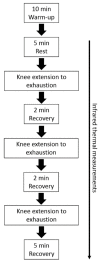Central and Peripheral Thermal Signatures of Brain-Derived Fatigue during Unilateral Resistance Exercise: A Preliminary Study
- PMID: 35205188
- PMCID: PMC8869276
- DOI: 10.3390/biology11020322
Central and Peripheral Thermal Signatures of Brain-Derived Fatigue during Unilateral Resistance Exercise: A Preliminary Study
Abstract
Infrared thermography (IRT) allows to evaluate the psychophysiological state associated with emotions from facial temperature modulations. As fatigue is a brain-derived emotion, it is possible to hypothesize that facial temperature could provide information regarding the fatigue related to exercise. The aim of this study was to investigate the capability of IRT to assess the central and peripheral physiological effect of fatigue by measuring facial skin and muscle temperature modulations in response to a unilateral knee extension exercise until exhaustion. Rate of perceived exertion (RPE) was recorded at the end of the exercise. Both time- (∆TROI: pre-post exercise temperature variation) and frequency-domain (∆PSD: pre-post exercise power spectral density variation of specific frequency bands) analyses were performed to extract features from regions of interest (ROIs) positioned on the exercised and nonexercised leg, nose tip, and corrugator. The ANOVA-RM revealed a significant difference between ∆TROI (F(1.41,9.81) = 15.14; p = 0.0018), and between ∆PSD of myogenic (F(1.34,9.39) = 15.20; p = 0.0021) and neurogenic bands (F(1.75,12.26) = 9.96; p = 0.0034) of different ROIs. Moreover, significant correlations between thermal features and RPE were found. These findings suggest that IRT could assess both peripheral and central responses to physical exercise. Its applicability in monitoring the psychophysiological responses to exercise should be further explored.
Keywords: frequency-domain analysis; infrared thermography; resistance training; strength training; thermal imaging; unilateral exercise.
Conflict of interest statement
The authors declare no conflict of interest.
Figures




Similar articles
-
Regions of interest selection and thermal imaging data analysis in sports and exercise science: a narrative review.Physiol Meas. 2021 Aug 27;42(8). doi: 10.1088/1361-6579/ac0fbd. Physiol Meas. 2021. PMID: 34186518 Review.
-
Non-obstructive monitoring of muscle fatigue for low intensity dynamic exercise with infrared thermography technique.Med Biol Eng Comput. 2021 Aug;59(7-8):1447-1459. doi: 10.1007/s11517-021-02387-x. Epub 2021 Jun 22. Med Biol Eng Comput. 2021. PMID: 34156602
-
Skin temperature response to unilateral training measured with infrared thermography.J Exerc Rehabil. 2017 Oct 30;13(5):526-534. doi: 10.12965/jer.1735046.523. eCollection 2017 Oct. J Exerc Rehabil. 2017. PMID: 29114526 Free PMC article.
-
Eye surface infrared thermography usefulness as a noninvasive method of measuring stress response in sheep during shearing: Correlations with serum cortisol and rectal temperature values.Physiol Behav. 2022 Jun 1;250:113781. doi: 10.1016/j.physbeh.2022.113781. Epub 2022 Mar 18. Physiol Behav. 2022. PMID: 35314176
-
Infrared Thermography in Exercise Physiology: The Dawning of Exercise Radiomics.Sports Med. 2020 Feb;50(2):263-282. doi: 10.1007/s40279-019-01210-w. Sports Med. 2020. PMID: 31734882 Review.
Cited by
-
Altered Microcirculation in Alzheimer's Disease Assessed by Machine Learning Applied to Functional Thermal Imaging Data.Bioengineering (Basel). 2022 Sep 21;9(10):492. doi: 10.3390/bioengineering9100492. Bioengineering (Basel). 2022. PMID: 36290459 Free PMC article.
-
Editorial: Effect of neurophysiological conditions and mental workload on physical and cognitive performances: a multidimensional perspective.Front Neuroergon. 2023 May 17;4:1215376. doi: 10.3389/fnrgo.2023.1215376. eCollection 2023. Front Neuroergon. 2023. PMID: 38234485 Free PMC article. No abstract available.
-
Can Data-Driven Supervised Machine Learning Approaches Applied to Infrared Thermal Imaging Data Estimate Muscular Activity and Fatigue?Sensors (Basel). 2023 Jan 11;23(2):832. doi: 10.3390/s23020832. Sensors (Basel). 2023. PMID: 36679631 Free PMC article.
References
-
- Vardasca R., Simoes R. Topics in Medical Image Processing and Computational Vision. Springer; Berlin/Heidelberg, Germany: 2013. Current Issues in Medical Thermography; pp. 223–237.
-
- Genno H., Ishikawa K., Kanbara O., Kikumoto M., Fujiwara Y., Suzuki R., Osumi M. Using Facial Skin Temperature to Objectively Evaluate Sensations. Int. J. Ind. Ergon. 1997;19:161–171. doi: 10.1016/S0169-8141(96)00011-X. - DOI
-
- Eysenck M.W., Calvo M.G. Anxiety and Performance: The Processing Efficiency Theory. Cogn. Emot. 1992;6:409–434. doi: 10.1080/02699939208409696. - DOI
-
- Cardone D., Perpetuini D., Filippini C., Spadolini E., Mancini L., Chiarelli A.M., Merla A. Driver Stress State Evaluation by Means of Thermal Imaging: A Supervised Machine Learning Approach Based on ECG Signal. Appl. Sci. 2020;10:5673. doi: 10.3390/app10165673. - DOI
LinkOut - more resources
Full Text Sources
Research Materials

